BMW’s updated its F900 roadster and F900 XR street-biased adventure tourer for 2025. Our man Alan Dowds spent a day on both bikes in Spain last week – here’s how he got on.
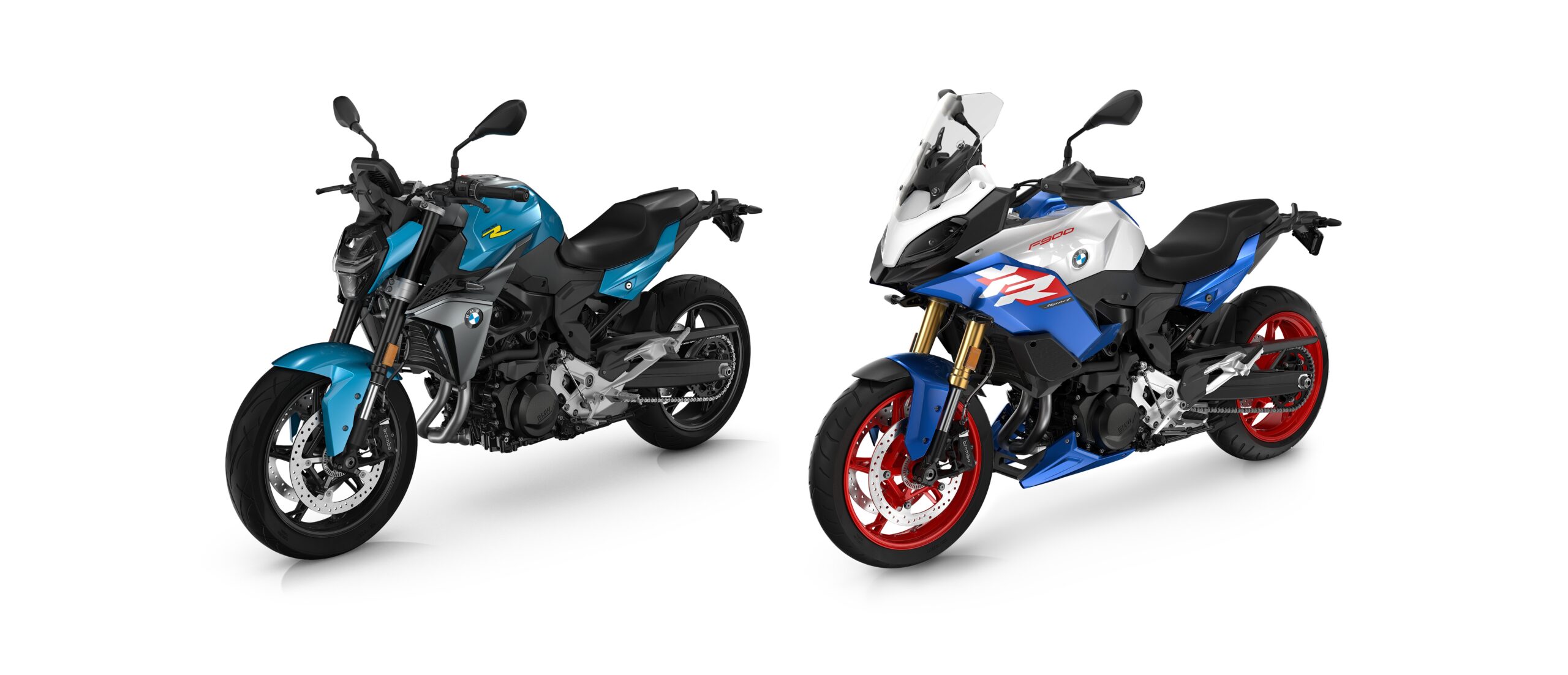
It’s nearly 20 years since BMW first launched its upper-middleweight parallel twin range with the F800S and ST sporty tourers. The German firm had been selling small-bore ‘F’ models since 1993, but only in single-cylinder 650 format, using a version of the Aprilia Pegaso 650 engine.
By 2006 though, BMW was getting serious about extending its model range out from the ‘traditional’ big Boxer engines, with new twin and four-cylinder powertrains.
The first twin-cylinder F models used an all-new engine with an unusual ‘nodding beam’ balancer system, and a 360° firing order, in a slightly quirky chassis, that featured a belt drive single-sided swingarm (but being a 2000s BMW design, it’s single-sided on the ‘wrong’ side, so you can’t really see it parked on the sidestand…)
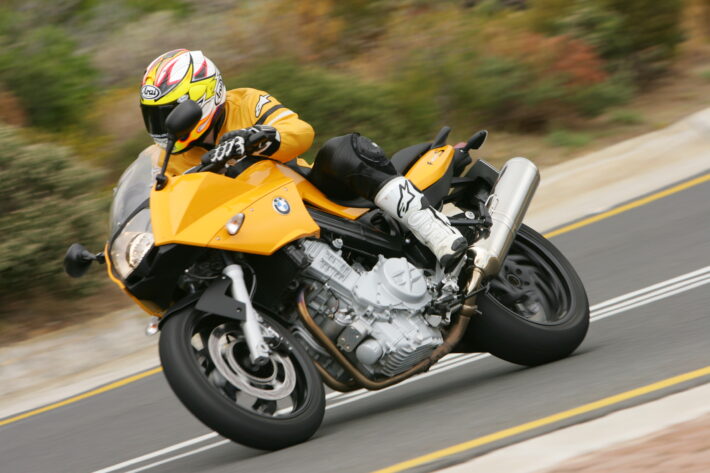
You also got the usual BMW options for useful kit: luggage, ABS, trip computers, heated grips and the like. I went to the launch of the 2006 F800S and ST in South Africa for SuperBike Magazine, and had a great time. Later, I spent a year testing the F800 R roadster variant, released in 2009, which had switched to a chain final drive and used styling similar to its bigger sibling, the K1200 R.
All those original F twin models were decent middleweight machines, though they lacked a little bit in the trousers department. They made a claimed 85bhp and weighed in around 200kg wet, so not at all slow, but against livelier competition like the Triumph Street Triple or Honda Hornet 600 they felt a little steady.
Nevertheless, the road variants trundled on through the 2010s, with a touring-focused 800 GT replacing the S and ST, as BMW concentrated on its popular GS adventure variants: the F700 and 800 GS, which grew into the 750/850 range.
2020 saw a total revamp of the range though, with a new 900 engine, and the launch of the F900 R and XR models alongside the GS range. More power, a 270° twin cylinder motor with conventional balancer shafts, plus a load more tech, brought the F-twins right up to date, and both road-focussed models carved out a useful niche for the firm alongside the more serious S1000 R and S1000 XR superbike-powered four-cylinder machines.
Fast-forward to 2025, and BMW’s given its 900 road twins another overhaul, with more equipment, sharpened handling, sportier chassis parts, plus styling tweaks. And I’m here, in Spain, 19 years on from the launch of the original F800, to check it all out.
BMW UK has brought us to Almeria – the driest part of Europe by all accounts – in early March for some guaranteed sunshine. Of course, the road testing gods love to mock, and we’ve got some very un-Spanish clouds in the sky as we line up outside the posh golfing hotel, and grab one of the bikes.
We’re out for the whole day, with a 50/50 mix of BMW F900 R and F900 XR machinery. Start the day on one, switch over at lunchtime, and get a proper all-round view of the new range is the plan, and it’s a good ‘un.
I’m issued with an XR to start with, and I get to grips with the setup pretty quickly.
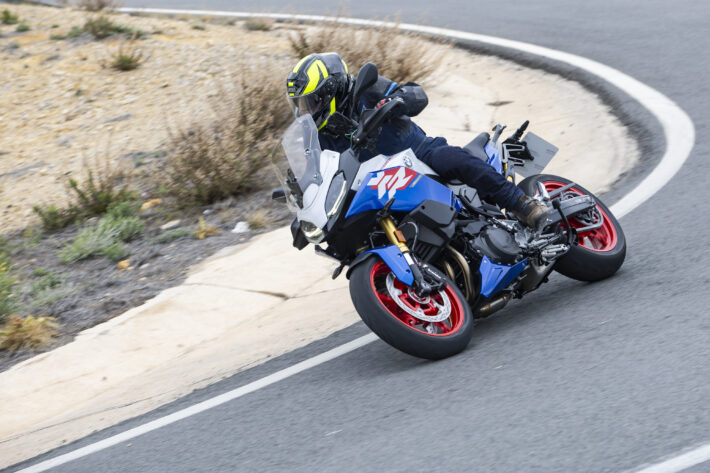
BMW’s various high-tech innovations are gradually filtering down through its entire range, so even this middleweight machine has piles of kit: keyless ignition, huge colour LCD dash, cruise control, electronic semi-active suspension on the rear shock, controller wheel on the left hand bar, and much more.
Some of this is optional, but the base level of standard kit has been upgraded for 2025, and the stock XR now comes with an impressive package of riding aids: Dynamic Traction Control (DTC), BMW Motorrad ABS Pro, Dynamic Brake Control (DBC) and the fancy adaptive Headlight Pro setup.
The upgrades continue in the chassis spec: a new upside-down front fork with full adjustability, and lighter cast aluminium wheels, which save nearly 2kg in unsprung mass, and are apparently the same design as used on the S1000 RR superbike.
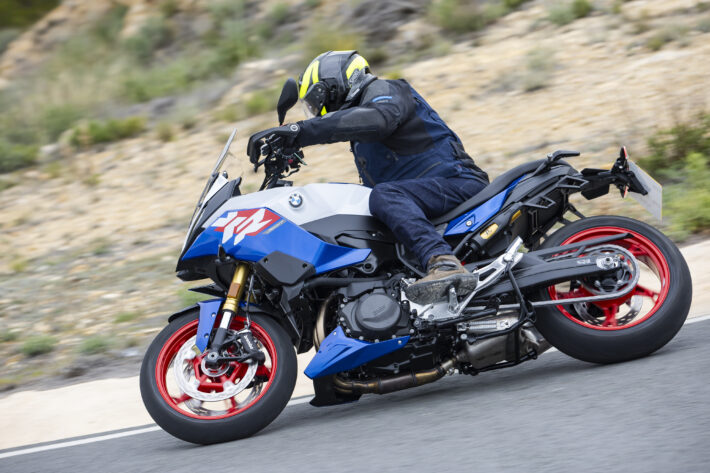
There’s a load of other detail mods – an 800 gramme lighter battery, revised riding position, better wind protection – but the engine is broadly as you were, apart from a new Euro5+ emissions setup. That leaves the peak power unchanged at a decent 105bhp, shoving along the 216kg kerb mass.
I clamp my iPhone mount on the bars, plug the lightning connector into the BMW’s USB-C power socket, connect up my headset, and get ready to go. Our lead rider today is Kevin Healey – owner of trackday and events firm Focused Events, which is looking after the logistics today.
He doesn’t hang about on a bike – I’ve ridden with him a few times before – and knows this part of the world like the back of his hand. So it looks like we’ll have a lively time on some of the excellent roads around here: hurray!
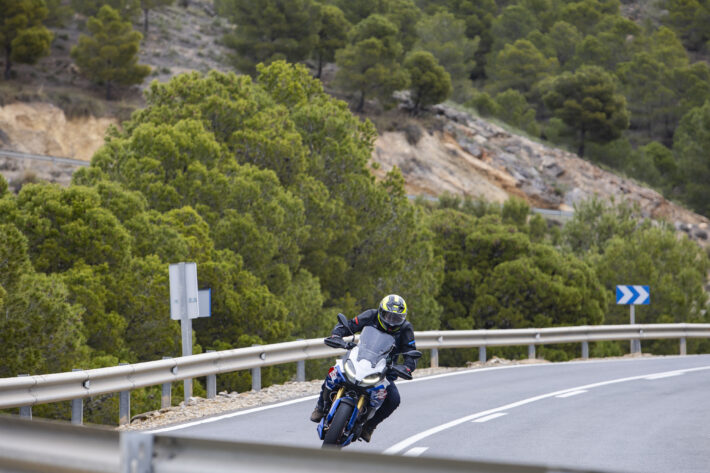
I last rode the old F900 XR a few years ago, but I’ve spent plenty of time on BMWs since, and there’s a definite corporate feel across all the Munich machines these days.
The great dashboard and switchgear setup is easy to manage once you learn it, and is broadly common across all the range, so I can quickly flip through menus and displays, checking out the electronic suspension settings, and dialling in the ‘sport’ dash display with the lean angle and braking power readouts.
Pulling away out of the hotel car park, the riding position feels easy and natural – it’s one of the great advantages for an old man of the adventure touring style bike.
We start out steady through town, but it’s not long before we’re heading into the hills, and the bends begin. Most of the changes for this year have focused on handling: lighter wheels and uprated forks should make a big difference, and while it’s always hard to compare an updated model without the old bike there, I’m certainly impressed by how the new XR rides.
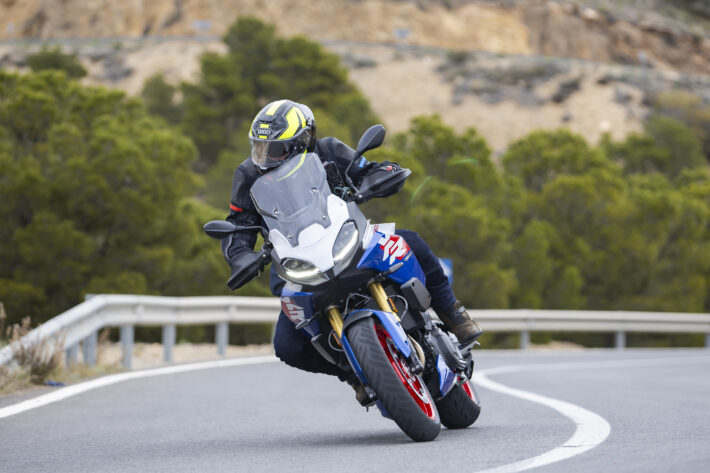
Kevin is riding an R1300 GS on roads he knows well, so keeping up takes a bit of effort, but the 900 makes it easy. The chassis feels sharp enough, with the new fork helping you get the most from the Brembo four-piston brakes up front and the Continental ContiRoad Attack 4 rubber on my bike.
The launch bikes have a weird mix of rubber fitments – some Pirellis, some Maxxis, some Continentals, but they all seem to be working well on the (admittedly dry) asphalt today. There’s loads of ground clearance on the XR: even hooning round a tight bend for pics you’ll not deck your toesliders unless you want to. And the semi-active rear shock responds well to sporty antics, keeping the back end taut when you slam on the gas out of the corner.
The engine performance is also solid, with sharp fuelling, snappy throttle response, and strong low-down grunt, all of which helps you drag round those tight Spanish hairpins and fire out the other side. The quickshifter is great, and in the ‘Dynamic’ riding mode, the whole thing feels very sporty indeed. ‘Only’ 105bhp might put you off, and for sure, if you love big-power antics like 150mph Autobahn cruising and third gear wheelies off the gas, you’ll need the S1000 XR instead. For most folk though, this is a lively, engaging powertrain package, that suits the bike right down to the ground.
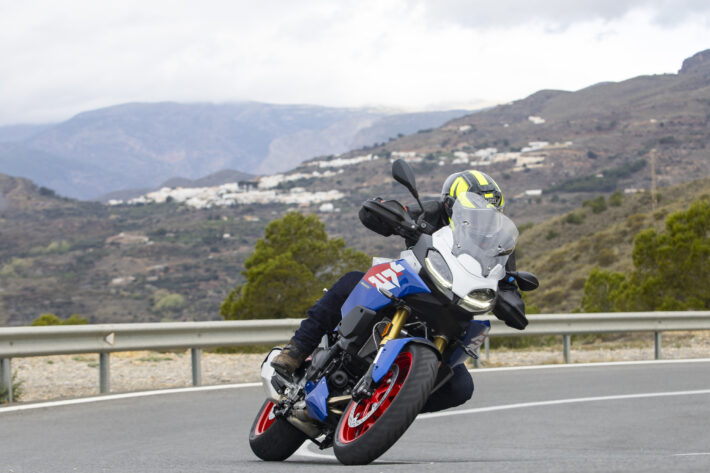
We’ve had the first photo stop, and now it’s time to put some miles on. I click the manual-adjust screen up into the high position, sit back, and relax, as we sail through the Andalusian landscape. Again, the XR feels assured in this role too: if I had some luggage on the back, and a full tank of gas, I’d be very happy to sit here with a 750-mile day ahead of me.
The new bodywork is protective, and the standard hand guards/hot grips combo is a useful touch of course, though not really needed today. Cruise control eases the pain on motorways, and my only complaint about touring life is the usual one these days – fit a bloody bigger tank!
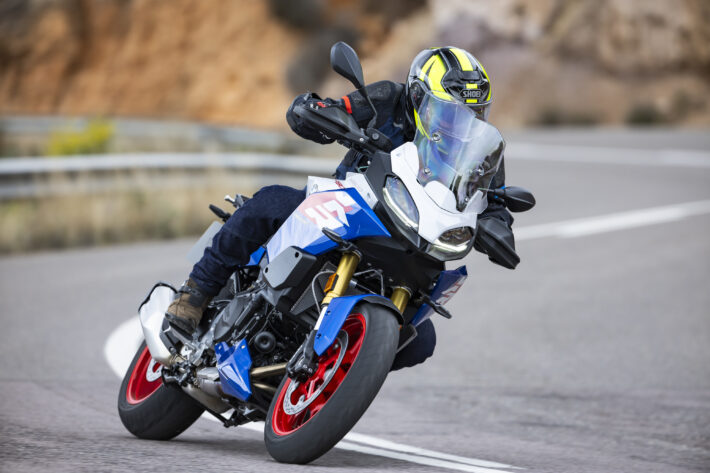
The XR has a 15.5 litre capacity, which is okay for what we’re doing today, but an extra couple of litres would make a big difference on a fast motorway tour, or for a mid-distance commuter.
After a light lunch at the Almeria circuit café, it’s time to check out the F900 R. It’s broadly identical to the XR, apart from the riding position, handlebars, lower seat, less bodywork, and shorter travel suspension (around 35/30mm less front/rear).
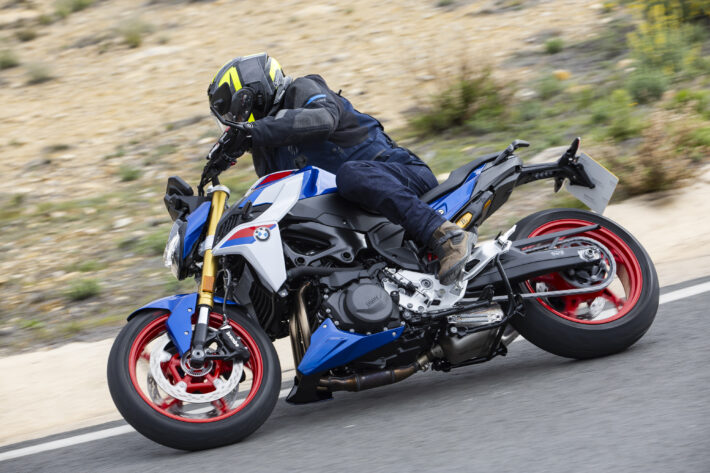
As a result, it instantly has a much sportier attitude, with a more uncompromising stance, and extra weight over the front. At the second photo stop, it (predictably) feels a bit sharper turning into the bend, and you automatically become a little more aggressive.
The R is 8kg lighter than the XR, which isn’t really going to make a night-and-day difference, but adds overall to the sportier character. I feel like I can brake a little bit harder going into a bend, with the excellent Brembo stoppers, and the front is more planted, with the shorter-travel forks and sportier weight balance.
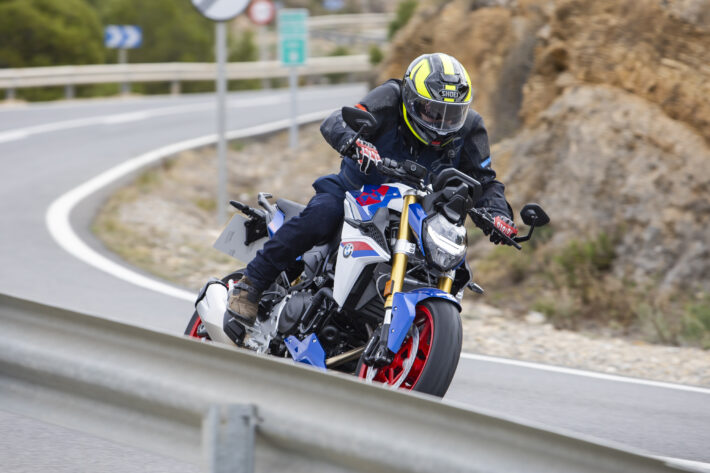
My bike has sportier Pirelli Diablo Rosso IV tyres too, adding to the capable chassis. It definitely feels much more chuckable, and for urban duties, would be a sleeker beast to thread through traffic jams and duck round buses.
Of course, the price for that comes when we head back to the hotel. On a fast run down some main trunk roads, the wind blast is much stronger on the naked bike and while it’s not at all cold today, I feel the breeze on my fingers from the lack of handguards.

Equipment-wise, we still have the cruise control, excellent dash and heated grips for touring comfort, but the fuel capacity is even less than the parsimonious XR’s 15.5 litres. The 900 R has just 13 litres of gas in its tank, which is frankly rubbish, even if you do ride slowly enough to get the claimed 67mpg (WMTC test cycle) on the BMW spec sheet. Even at 50mpg you’ll be looking for fuel around 120 miles, which I’d find pretty boring after a while…
So, 19 years after first riding BMW’s F-twins, how do the latest models shape up? Well, better, but broadly similar would be my take. The 900s are much sharper than the old 800s, with 25 per cent more power, far better chassis setups, and lashings of modern kit.
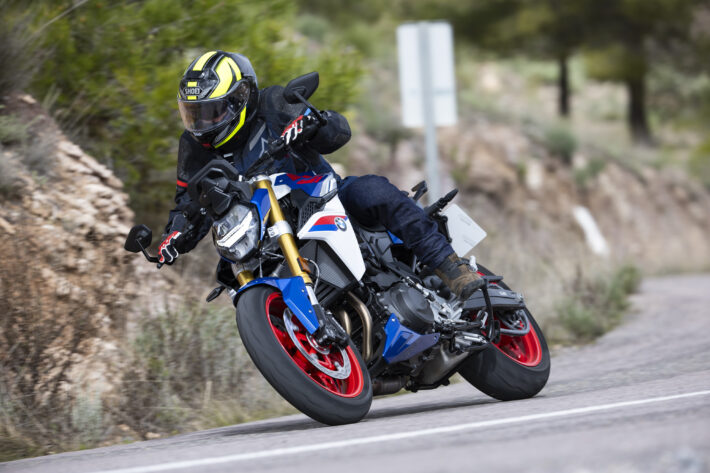
On the other hand, the competition is also better than it was back in the day: as an example, Yamaha didn’t have its MT-09 and Tracer 9 range back then, and the triple-powered Yams are solid competition, with 15bhp more power for around £1k more, depending on equipment spec.
It could be a tough choice to pick between those machines, depending on what you need from a bike – but I think the wide range of factory accessories and high-tech add-ons could well clinch the BMW option for me.
F900 R and XR tech highlights:
Engine
Parallel twin eight-valve, DOHC motor with a 270° firing order, based on the old F850 GS with more cubes, up to 895cc from 853cc, thanks to a 2mm overbore. Peak power on the 2025 bike stays the same as before at 105bhp, using ride-by-wire fuel injection, twin balance shafts, dry-sump lubrication system and a slipper clutch.
Frame
BMW’s fabricated sheet steel diamond type frame, which uses the motor as a bolted-in stressed member.
Suspension
The big update for 2025 is the front fork, which is now fully adjustable on the R and XR. The rear shock has optional Dynamic ESA – semi-active electronic adjustment of damping and preload.
Brakes
BMW’s stuck with the Brembo cast monoblock four-piston radial calipers from the first generation, rather than switching to the Nissin blue calipers on its fancy superbikes. There are 320mm discs up front, and a single-piston caliper with a 265mm disc at the back. Cornering ABS Pro is now standard fitment.
2025 BMW F900 R
- Complies with Euro 5+ emission standards.
- New ergonomics with optimised handlebar and
footrest position for improved riding position.
- New upside-down telescopic forks with adjustable damping rebound and compression damping and spring preload.
- New wheels, approx. 1.8 kg lighter.
- New battery, approx. 0.8 kg lighter.
- Dynamic Traction Control DTC, BMW Motorrad ABS Pro and
Dynamic Brake Control DBC.
- Slim rear end with integrated turn indicator lights.
- New colours.
- New genuine BMW Motorrad accessories such as sports silencer in collaboration with Akrapovič, milled footrests and foot levers as well as axle protectors and lockable soft cases.
- New Sport seat (+25mm height) available as optional equipment ex works.
2025 BMW F900 XR
- Complies with Euro 5+ emission standards.
- Increased wind and weather protection thanks to optimised wind deflector.
- Hand protectors.
- Heated grips.
- New upside-down telescopic forks with adjustable damping rebound and compression damping and spring preload.
- New wheels, approx. 1.8 kg lighter.
- New battery, approx. 0.8 kg lighter.
- Dynamic Traction Control DTC, BMW Motorrad ABS Pro and Dynamic Brake Control DBC.
- Headlight Pro (daytime running light and adaptive headlight).
- USB charging port.
- Slim rear end with integrated turn indicator lights.
- New colours.
- New genuine BMW Motorrad accessories such as sports silencer in collaboration with Akrapovič, milled footrests and foot levers as well as axle protectors and lockable soft cases.
- New high seat (+25mm) available as optional equipment ex works.
- New high windshield (+30mm) available as optional equipment ex works.
SPECIFICATIONS
F900 R (XR in brackets)
Price: from £9,090 (£10,890)
Engine: DOHC 8v, parallel twin, l/c, 895cc, dry sump
Bore x stroke: 86x77mm
Compression ratio: 13.1:1
Carburation: BMS-ME ride-by-wire fuel injection
Max power (claimed) 105bhp@8,500rpm
Max torque (claimed) 69ft lb@6,750rpm
Transmission: six speed gearbox, wet slipper clutch, chain final drive
Frame: bridge-type fabricated steel
Front suspension: 43mm USD ZF front fork, fully-adjustable, 135mm (170mm) travel
Rear suspension: aluminium swingarm, fully -adjustable ZF monoshock, [optional Dynamic ESA electronic semi-active suspension adjustment], 142mm (172mm) travel
Brakes: dual 320mm discs, four-piston radial-mount calipers (front), 265mm disc, single-piston sliding caliper (rear), BMW Motorrad ABS Pro
Wheels/tyres: cast aluminium wheels, 120/70 17 front, 180/55 17 rear
Rake/trail: 26°/114mm (105mm)
Wheelbase: 1,514mm (1,535mm)
Seat height [two positions]: 760/835mm (775/845mm)
Kerb weight: 208kg (216kg)
Fuel capacity: 13 litres (15.5 litres)
Image Credit – Jamie Morris/BMW
Alan Dowds has been riding bikes since 1989, and working as a motorcycle journalist since 1995. He’s written for Motorcycle News, RiDE, SuperBike, Fast Bikes, MSL and CMM magazines, amongst others, and ridden almost everything, from 50cc mopeds and electric scooters, to WSBK and MotoGP racebikes. He’s also written several books about bikes, including his latest work celebrating 100 years of BMW Motorrad.
Al’s our Devitt news hound, tracking down new bikes to ride and write about, as well as the in-house bike tech expert.
